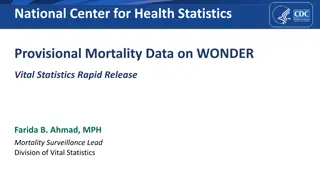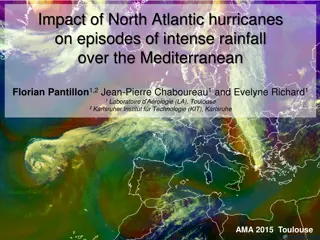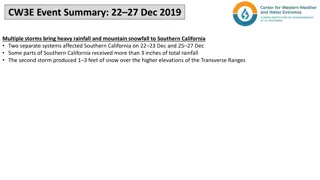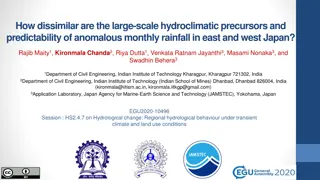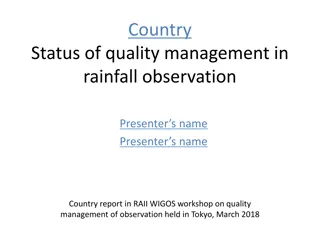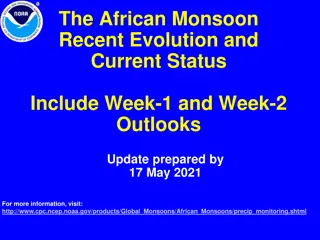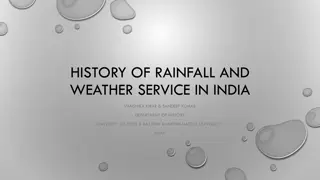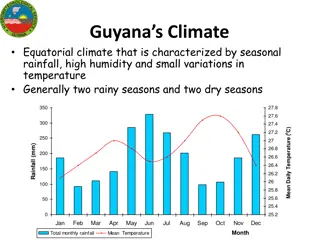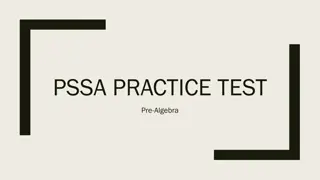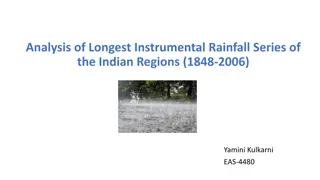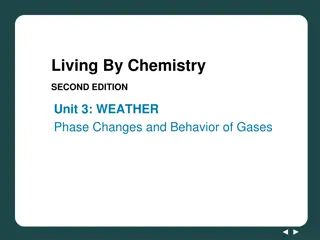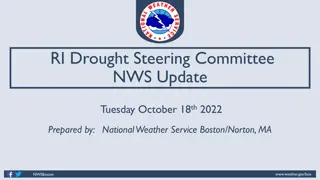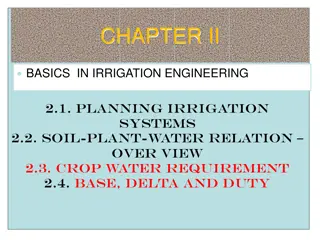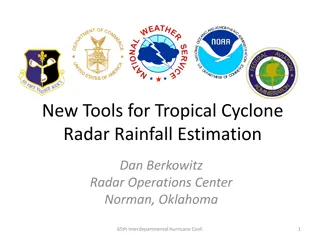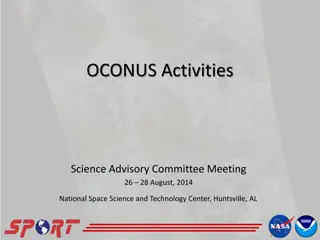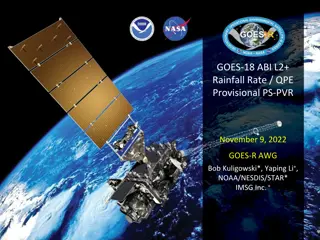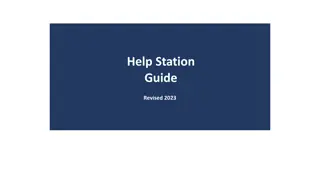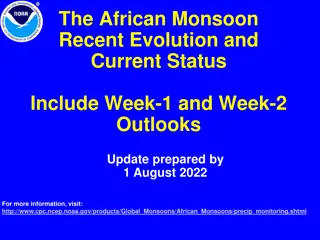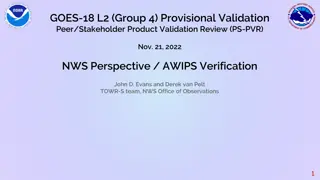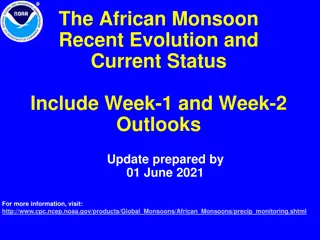Overview of GOES-16 Rainfall Rate/QPE Provisional Evaluation
The provisional evaluation of the GOES-16 Rainfall Rate/QPE product outlines the approach, major issues, and path to validation maturity. The product utilizes single-image data from various spectral bands to estimate rainfall rates with precise accuracy. Calibration equations were developed for different cloud types to enhance performance. The product specifications detail the geographic coverage, measurement range, accuracy, refresh rate, and precision. The timeline from GOES-R launch to product development is also provided.
Download Presentation

Please find below an Image/Link to download the presentation.
The content on the website is provided AS IS for your information and personal use only. It may not be sold, licensed, or shared on other websites without obtaining consent from the author. Download presentation by click this link. If you encounter any issues during the download, it is possible that the publisher has removed the file from their server.
E N D
Presentation Transcript
GOES-16 ABI L2+ Rainfall Rate / QPE Provisional PS-PVR March 30, 2018 GOES-R AWG Bob Kuligowski*, Yaping Li+, NOAA/NESDIS/STAR* IMSG Inc.+ 1
Outline Review of Beta Maturity Product Quality Evaluation General approach Major Issues Remaining Provisional Maturity Assessment Path to Full Validation Maturity Issues and status Risks Summary and Recommendations 2
GOES-16 Rainfall Rate / QPE L2 Product Provisional PS-PVR REVIEW OF BETA MATURITY 3
Product Overview The GOES-R ABI Rainfall Rate / QPE uses single-image data from five different spectral bands to retrieve estimates of instantaneous rainfall rate at the full IR pixel scale for the entire full disk. These five bands are transformed into 16 predictors, 8 of which are nonlinear transformations of the first 8: T6.2 - 174 K T8.5 - T7.34+ 30 K T11.2- T7.34+ 20 K T8.5- T11.2+ 30 K T11.2- T12.3+ 20 K S = 0.568*(Tmin,11.2-217 K) + 25 K Tavg,11.2 - Tmin,11.2 (S 25 K) + 85 K T7.34 - T6.19+ 30 K Separate pairs of predictors from this set are used for rain / no rain discrimination (linear only) and rain rate retrieval (both). NOTE: This product has no precedents; i.e., it uses only L1b radiances as input. 4
Product Overview Separate rain / no rain and rain rate retrieval equations were calibrated against microwave rain rates (CPC MWCOMB). The algorithm was designed to allow real-time updating of the calibration coefficients, but the operational code has a fixed set. Separate calibration equations were developed for each 30 latitude band and each of 3 different cloud types: Type 1 ( water cloud ): T7.34<T11.2 and T8.5-T11.2<-0.3 Type 2 ( ice cloud ): T7.34<T11.2 and T8.5-T11.2 -0.3 Type 3 ( cold-top convective cloud ): T7.34 T11.2 The resulting rain rates are then adjusted to match the distribution of the calibration MW rain rates using LUTs based on PDF matching of the initial output rain rates with MWCOMB. 5
Product Overview: Specifications Rainfall Rate / QPE Geographic Coverage Full Disk Measurement Range 0-100 mm/h Measurement Accuracy Refresh Rate Measurement Precision Specification 6 mm/h at a rate of 10 mm/h with higher values at higher rates 15 min (Mode 3 and Mode 4) 9 mm/h at a rate of 10 mm/h with higher values at higher rates 6
Review: Time-Line/Context 19 Nov 2016 GOES-R Launch 29 Nov 2016 GEO orbit attained (became GOES-16) 03 Jan 2017 ABI aperture door open/1st light for visible/near- infrared channels Mid Jan 2017: AWG established access to GS L2 products. Qualitative RRQPE L2 product validation begins. 1 March 2018: L1b is Beta validated; quantitative RRQPE L2 product validation begins. 16 May 2017 Conditional PS-PVR Beta 13 September 2017 Full PS-PVR Beta 7
Beta PLPTs Under Review PLPT ID Descriptive Title % Complete Results AWG POC Verify Product is generated every 15 min for FD for M3 ABI-FD_QPE01 100 Complete PRO Verify Product is generated every 15 min for FD for M4 ABI-FD_QPE02 100 Complete PRO Assess accuracy and precision of product ABI-FD_QPE03 100 Complete AWG 8
Definitions of Metrics for ABI- FD_QPE03 Accuracy=Absolute difference in average rain rate between satellite and validation data Precision=68thpercentile of absolute difference between satellite and validation data Additional details: Stats are computed only for pixels with satellite rain rates of 9.5-10.5 mm/h Computed over all data between 60 S and 60 N and for satellite zenith angles 70 Each satellite pixel is matched with the GV pixel within 15 km that has the closest value 9
Results of ABI-FD_QPE03 (mm/h) Spec Vs. MRMS Vs. DPR Accuracy 6.00 7.47 7.93 Precision 9.00 9.58 9.85 Computed for a total of 3,942,200 pixels (MRMS) and 40,913 pixels (DPR) with corresponding satellite rain rates of 9.5-10.5 mm/h for 1 March - 2 May 2017. For DPR, only pixels with latitude 60 and satellite zenith angle 70 were considered as per stated requirements. FAILED 10
Performance Issue Identified False rain in high latitudes during cool season due to WV band differences between SEVIRI and ABI (and limb cooling) Some evidence of this (due to limb cooling) in in SEVIRI during v5 algorithm evaluation over Western Europe--did not meet spec when validated against NIMROD radar but met spec comfortably vs. TRMM) However, magnitude is much greater for GOES-16 than for the original SEVIRI v5 validation vs. NIMROD apparent cause is difference in WV passbands between SEVIRI and ABI 11
Performance Issue Addressed Developed and tested a new set of calibration coefficients that were based on the GOES-16 ABI WV bands Largely eliminated high-latitude false rainfall. Original Coefficients New Coefficients con.V5y.Q3.ctl 12
Validation Results for Updated Coefficients Original Coefficients Updated Coefficients Computed for 1 March 30 August 2017. 13
Validation Results for Updated Coefficients (mm/h) Spec Vs. MRMS Vs. DPR Old New Old New Accuracy 6.00 6.53 3.87 7.60 5.11 Precision 9.00 9.54 7.85 9.71 8.48 Computed for pixels with retrieved rain rates of 9.5-10.5 mm/h for 1 March 30 August 2017. For DPR, only pixels with latitude 60 and satellite zenith angle 70 were considered as per stated requirements. Passed 14
Validation Results for Updated Coefficients Precision Original Coefficients Accuracy Number of Data Points New Coefficients Computed for pixels with retrieved rain rates of 9.5-10.5 mm/h for 1 March 30 August 2017. 15
Validation Results for Updated Coefficients Precision Original Coefficients Accuracy Number of Data Points Computed for pixels with retrieved rain rates of 9.5-10.5 mm/h for 1 March 30 August 2017. 16
Validation Results for Updated Coefficients Precision New Coefficients Accuracy Number of Data Points Computed for pixels with retrieved rain rates of 9.5-10.5 mm/h for 1 March 30 August 2017. 17
Issue Needing Resolution for Full Beta Maturity Title Description Impact Mitigation Status The current static calibration file is producing significant amounts of false rainfall that has been traced back to the differences in the WV passbands between SEVIRI (on which the calibration was initially developed) and ABI. Significant amounts of false precip in cold clear air. Installed ADR412 PR05.02 16 May 2017 Conditional PS-PVR Beta 13 September 2017 PR05.02 installed 13 September 2017 Full PS-PVR Beta 18
Another Performance Issue The false rain returned with a vengeance during the severe cold air outbreak in late December It was discovered that certain channel combinations (T11.2-T7.34 and T8.5- T7.34) that were very skillful for rain-no rain detection (identifying overshooting tops) were also susceptible to mistaking extremely cold air for rainfall (low-level inversions give the same signal) 19
Another Performance Issue The false rain returned with a vengeance during the severe cold air outbreak in late December Removing these channel combinations from the predictor set resolved the problem However, it also degraded performance in some other instances since some ability to distinguish overshooting tops from cirrus was lost 20
Issues Needing Resolution for Provisional Maturity Title Description Impact Mitigation Status The cold air outbreak over the northeastern US was far colder than anything in the previous test dataset, and the calibration coefficient fix that worked late last winter is producing false rain signatures in this cold air. Significant amounts of false rainfall in cold clear air. Installed ADR559 PR06.08 30 Nov 11 Dec 2017 Spacecraft Drift to East Slot 25 January 2018 PR06.08 installed 30 March 2018 Provisional PS-PVR 21
GOES-16 Rainfall Rate / QPE L2 Product Provisional PS-PVR PRODUCT QUALITY EVALUATION 22
Provisional PLPT PLPT ID Descriptive Title % Complete Results AWG POC Assess accuracy and precision of product ABI-FD_QPE04 100 Complete AWG 23
Top Level Evaluation Past Performance (at Beta PS-PVR) Current Status Future Outlook Conditionally passed for 2 months data; passed after coefficient updates Accuracy and precision specs not met on 2 months data before coefficient updates but met on 6 months data after coefficient updates Identified Issues: Calibration coefficients based on SEVIRI were not appropriate for ABI when WV passbands were involved; result was widespread heavy rainfall in cold air A cold air outbreak in December revealed that some predictors using the difference between the IR window and WV bands were mistaking surface inversions for rainfall, resulting in widespread light rain in very cold air. A second set of emergency coefficient updates in January (prior to the pre-launch code freeze) largely resolved this issue. Accuracy and precision specs are met for 1 year of (largely) reprocessed data over the CONUS, though not at every point in the CONUS. Spec is not met when the rest of the FD is included. Expect further improvements in the rain rate product with another improved set of calibration coefficients that is more seasonally robust However, all science code improvements are needed to realize full potential Quantitative Performance: (Accuracy, Precision) 24
Comparison of GS and STAR Stats Reprocessed and operational stats converge after OE update on 25 January; differences due mainly to rounding errors. 25
Results of ABI-FD_QPE04 (mm/h) Spec Vs. MRMS Vs. DPR Ops Sci Ops Sci Accuracy 6.00 4.51 3.01 7.05 5.66 Precision 9.00 8.83 4.75 9.70 9.40 Operational rain rates meet spec over the CONUS vs. Q3 but not over the full disk vs. DPR Science code rain rates meet spec over the CONUS by a wide margin and meet accuracy spec vs. DPR but not precision--due to performance issues during DJF that are still being investigated 26
1-Year Validation Results Accuracy Precision Number of Data Points Operational Algorithm (with January 2018 coefficients) Science Code Computed for pixels with retrieved rain rates of 9.5-10.5 mm/h for 1 March 2017 28 February 2018. 27
1-Year Validation Results Accuracy Precision Operational Code Number of Data Points Computed for pixels with retrieved rain rates of 9.5-10.5 mm/h for 1 March 2017 28 February 2018. 28
1-Year Validation Results Accuracy Precision Science Code Number of Data Points Computed for pixels with retrieved rain rates of 9.5-10.5 mm/h for 1 March 2017 28 February 2018. 29
Monthly Validation Results The operational QPE consistently meets spec and outperforms the GHE in the warm season vs. Q3 The operational QPE and GHE both consistently fail to meet spec vs. DPR The operational code does very poorly in Dec 2017 and Feb 2018; the cause is still under investigation 30
Monthly Validation Results The operational QPE has higher correlation and less bias than the GHE in the warm season vs. Q3, but not in the cool season Significant amounts of false-alarm rainfall in the operational QPE in December and February vs. DPR causing high bias; less so vs. Q3 31
Monthly Validation Results August 2017 February 2018 The operational QPE tends more toward overestimation than underestimation not much missed rainfall in the summer Significant increase in false alarms over CONUS is apparently explained by cool season, but they have been found in the Southern Hemisphere during January also 32
Top Level Summary of Product Quality The two coefficient updates significantly improved product quality; however there is still a significant amount of false- alarm rainfall in the cool season The product meets spec over most of the CONUS, but not all of it, and not at all times Is meeting spec over the CONUS (as a whole) sufficient, or does it have to meet spec everywhere? 33
GOES-16 Rainfall Rate / QPE L2 Product Provisional PS-PVR PROVISIONAL MATURITY ASSESSMENT 34
Provisional Validation Preparation Activities Assessment Validation activities are ongoing and the general research community is now encouraged to participate. Validation activities are ongoing. Operational and algorithm anomalies have been identified. Critical ones have been resolved (PR05.02 and PR06.08); however, a new ADR will be needed when the cause(s) of the cool-season false alarms have been identified and addressed. Severe algorithm anomalies are identified and under analysis. Solutions to anomalies are in development and testing. Incremental product improvements may still be occurring. Incremental product improvements are expected. 35
Provisional Validation End State Assessment Product performance has been demonstrated through analysis of a small number of independent measurements obtained from select locations, periods, and associated ground truth or field campaign efforts. This has been demonstrated. Product analysis is sufficient to communicate product performance to users relative to expectations (Performance Baseline). This has been communicated in PS-PVR. Documentation of product performance exists that includes recommended remediation strategies for all anomalies and weaknesses. Any algorithm changes associated with severe anomalies have been documented, implemented, tested, and shared with the user community. These are documented in this slide deck and will be documented in a separate report and ReadMe file. Testing will be documented in a PLPT Report. Testing has been fully documented. Product is ready for operational use and for use in comprehensive cal/val activities and product optimization. We concur. 36
Recommendation AWG Hydrology Team believes that the GOES- 16 Rainfall Rate / QPE product has reached the Provisional Maturity as defined by the GOES-R Program Technically does not meet spec over the full disk, but NWS users are primarily in the CONUS 37
GOES-16 Rainfall Rate / QPE L2 Product Provisional PS-PVR PATH TO FULL VALIDATION MATURITY 38
Issues and Status ADRs Needing Resolution for Full VAL No outstanding ADRs at this time. 39
Issues and Status Other Actions Needed for Full VAL Desired Action Title Implementation Date into OE Rainfall Rate algorithm Definitively determine the case of the increased false alarm rainfall in DJF and attempt to develop a set of fixed coefficients that can address the issue without significantly compromising performance elsewhere 1 month prior to PS-PVR FULL New ADR needed 40
Path to Full Validation - PLPTs PLPT ID Descriptive Title Assess accuracy and precision of Rainfall Rate / QPE product vs. reference / ground truth data. ABI-FD_QPE05 AWG Hydrology Team will conduct these tests to further evaluate the L2 Rainfall Rate / QPE product quality. Full test plans and procedures are given in the Rainfall Rate / QPE Readiness, Implementation, and Management Plan (RIMP) 41
Path to Full Validation Risks Risk Name Description Impact Mitigation and Schedule IF corrections for known anomalies cannot be implemented in timely manner THEN the operation will not reach steady state for evaluation Raise awareness Work with Ground Operation Stability Update rain rate coefficients As discussed Moderate New WR/ADR needed; ASAP 42 Moderate Impact Little Impact Big Impact
GOES-16 Rainfall Rate / QPE Product Provisional PS-PVR SUMMARY & RECOMMENDATIONS 43
Summary Overall, the Rainfall Rate / QPE product performance is significantly improved since the Beta PS-PVR (June 2017). Improvements came with PR05.2 and PR06.08 Measured Rainfall Rate / QPE performance against reference data Accuracy and precision spec met over CONUS when validated vs. MRMS Q3 Accuracy and precision spec not met over much of the FD when validated vs. GPM DPR Still significant amounts of false alarm rainfall of as yet uncertain origin 44
Recommendation AWG Hydrology Team believes that the GOES- 16 Rainfall Rate / QPE product has reached the Provisional Maturity as defined by the GOES-R Program Technically does not meet spec over the full disk, but NWS users are primarily in the CONUS 45



